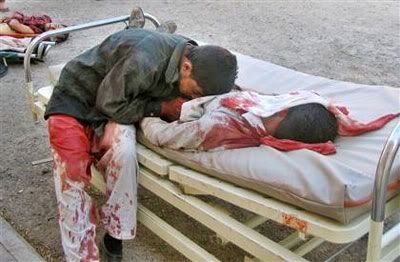Posted by sakerfa on February 25, 2010
(ProjectCensored) – Over one million Iraqis have met violent deaths as a result of the 2003 invasion, according to a study conducted by the prestigious British polling group, Opinion Research Business (ORB). These numbers suggest that the invasion and occupation of Iraq rivals the mass killings of the last century—the human toll exceeds the 800,000 to 900,000 believed killed in the Rwandan genocide in 1994, and is approaching the number (1.7 million) who died in Cambodia’s infamous “Killing Fields” during the Khmer Rouge era of the 1970s.
Project Censored
February 25, 2010

The human toll exceeds the 800,000 to 900,000 believed killed in the Rwandan genocide in 1994, and is approaching the number (1.7 million) who died in Cambodia’s infamous “Killing Fields” during the Khmer Rouge era of the 1970s.
Student Researchers: Danielle Stanton, Tim LeDonne, and Kat Pat Crespán
Faculty Evaluator: Heidi LaMoreaux, PhD
ORB’s research covered fifteen of Iraq’s eighteen provinces. Those not covered include two of Iraq’s more volatile regions—Kerbala and Anbar—and the northern province of Arbil, where local authorities refused them a permit to work. In face-to-face interviews with 2,414 adults, the poll found that more than one in five respondents had had at least one death in their household as a result of the conflict, as opposed to natural cause.
Authors Joshua Holland and Michael Schwartz point out that the dominant narrative on Iraq—that most of the violence against Iraqis is being perpetrated by Iraqis themselves and is not our responsibility—is ill conceived. Interviewers from the Lancet report of October 2006 (Censored 2006, #2) asked Iraqi respondents how their loved ones died. Of deaths for which families were certain of the perpetrator, 56 percent were attributable to US forces or their allies. Schwartz suggests that if a low pro rata share of half the unattributed deaths were caused by US forces, a total of approximately 80 percent of Iraqi deaths are directly US perpetrated.
Even with the lower confirmed figures, by the end of 2006, an average of 5,000 Iraqis had been killed every month by US forces since the beginning of the occupation. However, the rate of fatalities in 2006 was twice as high as the overall average, meaning that the American average in 2006 was well over 10,000 per month, or over 300 Iraqis every day. With the surge that began in 2007, the current figure is likely even higher.
Schwartz points out that the logic to this carnage lies in a statistic released by the US military and reported by the Brookings Institute: for the first four years of the occupation the American military sent over 1,000 patrols each day into hostile neighborhoods, looking to capture or kill “insurgents” and “terrorists.” (Since February 2007, the number has increased to nearly 5,000 patrols a day, if we include the Iraqi troops participating in the American surge.) Each patrol invades an average of thirty Iraqi homes a day, with the mission to interrogate, arrest, or kill suspects. In this context, any fighting age man is not just a suspect, but a potentially lethal adversary. Our soldiers are told not to take any chances (see Story #9).
According to US military statistics, again reported by the Brookings Institute, these patrols currently result in just under 3,000 firefights every month, or just under an average of one hundred per day (not counting the additional twenty-five or so involving our Iraqi allies). Thousands of patrols result in thousands of innocent Iraqi deaths and unconscionably brutal detentions.
Iraqis’ attempts to escape the violence have resulted in a refugee crisis of mammoth proportion. According to the United Nations Refugee Agency and the International Organization for Migration, in 2007 almost 5 million Iraqis had been displaced by violence in their country, the vast majority of which had fled since 2003. Over 2.4 million vacated their homes for safer areas within Iraq, up to 1.5 million were living in Syria, and over 1 million refugees were inhabiting Jordan, Iran, Egypt, Lebanon, Turkey, and Gulf States. Iraq’s refugees, increasing by an average of almost 100,000 every month, have no legal work options in most host states and provinces and are increasingly desperate.1
Yet more Iraqis continue to flee their homes than the numbers returning, despite official claims to the contrary. Thousands fleeing say security is as bad as ever, and that to return would be to accept death. Most of those who return are subsequently displaced again.
Maki al-Nazzal and Dahr Jamail quote an Iraqi engineer now working at a restaurant in Damascus, “Return to Iraq? There is no Iraq to return to, my friend. Iraq only exists in our dreams and memories.”
Another interviewee told the authors, “The US military say Fallujah is safe now while over 800 men are detained there under the worst conditions. . . . At least 750 out of the 800 detainees are not resistance fighters, but people who refused to collaborate with occupation forces and their tails.” (Iraqis who collaborate with occupation forces are commonly referred to as “tails of the Americans.”)
Another refugee from Baghdad said, “I took my family back home in January. The first night we arrived, Americans raided our house and kept us all in one room while their snipers used our rooftop to shoot at people. I decided to come back here [Damascus] the next morning after a horrifying night that we will never forget.”
http://dprogram.net/2010/02/25/top-project-censored-story-of-2009-u-s-war-machine-kills-over-one-million-iraqis/